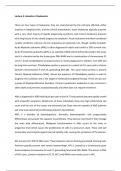Lecture 4. Genetics of leukaemia
There are four types of leukaemia, they are characterised by the cell type affected, either
myeloid or lymphoid cells, and the clinical presentation, acute leukaemia typically presents
with a very short history of rapidly progressing symptoms and chronic leukaemia presents
with long history of very slowly progressive symptoms. Acute leukaemia are often considered
curable conditions whereas chronic leukaemia are generally not, though readily treatable.
Acute Myeloid Leukaemia (AML) is often diagnosed in adults and confers a 50% survival rate.
Acute Promyeloid Leukaemia (APL) is an example of AML which will be discussed in this essay
and it is characterised by the fusion gene PML-RARA due to translocation of chromosome 15
and 17. Acute Lymphoblastic Leukaemia (ALL) is mostly diagnosed in children, over 90% will
be long term survivors. Philadelphia positive is present in a subset of ALL cases and is a fusion
between chromosomes 9 and 22, generating BCR-ABL. This same fusion protein is present
Chronic Myeloid leukaemia (CML), where the presence of Philadelphia positive is used to
diagnose this condition and is the target of molecularly targeted therapy. There are also are
a group of Myeloproliferative Disorders. Chronic Lymphocytic Leukaemia is very common in
older adults and presents asymptomatically and often does not require treatment.
AML is diagnosed in 3000 individuals per year in the UK. These patients become rapidly unwell
with unspecific symptoms. Blood tests of these individuals show very high white blood cell
count and the rest of the counts are extremely low. Bone marrow samples of AML patients
will only show abnormal proliferating leukemic haemoblasts.
AML is a disorder of haematopoiesis. Normally, haematopoietic cells progressively
differentiate and acquire the capacity to proliferate. They become restricted in their lineage
the more they differentiate. Malignant transformation in AML occurs at the stem or
progenitor level which causes the proliferation of cells in a precursors state. These cells will
accumulate and compete against normal healthy cells, causing the symptoms of the disease.
APL accounts for 10% of AML cases. These leukemic cells are heavily granulated, forming rods.
Patients typically present with severe haemorrhage. APL is caused by a chromosome gene
fusion between chromosome 15 and 17, generating functional PML-RARA. This occurs in 95%
of APL cases, somatic mutations in FLT3, WT1 and NRAS more rarely occur in APL.




